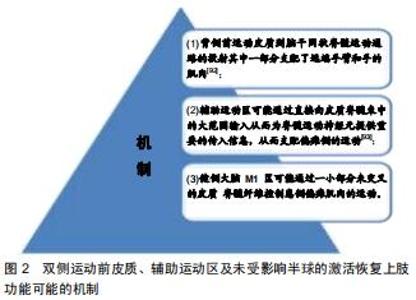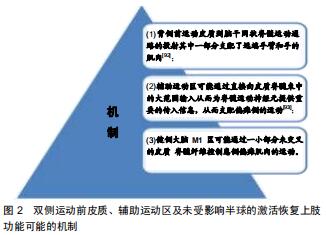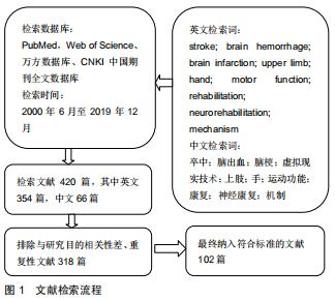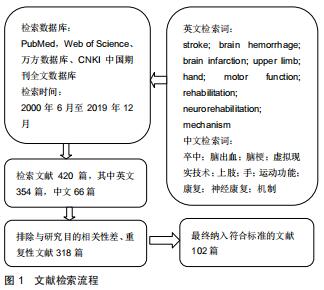Chinese Journal of Tissue Engineering Research ›› 2020, Vol. 24 ›› Issue (32): 5228-5235.doi: 10.3969/j.issn.2095-4344.2872
Previous Articles Next Articles
Application and mechanism of virtual reality technology in post-stroke rehabilitation of the hemiplegic upper limb
Cai Danxian1, Zeng Qing1, He Longlong1, Huang Guozhi1, 2
1Department of Rehabilitation, Zhujiang Hospital of Southern Medical University, Guangzhou 510280, Guangdong Province, China; 2Medical College of Rehabilitation, Southern Medical University, Guangzhou 510280, Guangdong Province, China
-
Received:2020-02-22Revised:2020-02-29Accepted:2020-04-10Online:2020-11-18Published:2020-09-26 -
Contact:Huang Guozhi, MD, Chief physician, Department of Rehabilitation, Zhujiang Hospital of Southern Medical University, Guangzhou 510280, Guangdong Province, China; Medical College of Rehabilitation, Southern Medical University, Guangzhou 510280, Guangdong Province, China -
About author:Cai Danxian, MD candidate, Department of Rehabilitation, Zhujiang Hospital of Southern Medical University, Guangzhou 510280, Guangdong Province, China -
Supported by:the National Natural Science Foundation of China (General Program), No. 81874032; Guangdong Provincial Medical Science and Technology Research Project, No. A2017610
CLC Number:
Cite this article
Cai Danxian, Zeng Qing, He Longlong, Huang Guozhi. Application and mechanism of virtual reality technology in post-stroke rehabilitation of the hemiplegic upper limb[J]. Chinese Journal of Tissue Engineering Research, 2020, 24(32): 5228-5235.
share this article

目前关于运动功能恢复机制的主流观念是基于半球间抑制模型,认为半球间失衡与偏瘫肢体运动功能障碍有关。据统计,大多数研究将半球间不平衡状态的恢复作为治疗目标。依据半球抑制模型的理论假设,健侧半球在卒中早期应该处于高度兴奋状态,但是XU等[87]对卒中后上肢轻-中度偏瘫患者进行为期1年的观察却发现,患者运动前半球间失衡从急性/亚急性期到慢性期呈现的变化为从正常进展为异常。而最近一项利用经颅磁比较脑卒中患者和健康成人双侧半球兴奋性的荟萃分析也得出结论,无论是在卒中后的急性期还是慢性期,“没有明确的证据表明健侧半球具有高度兴奋性”[88]。这些发现都与半球间抑制模型相违背,那么应该存在另一个可能更合适的理论来解释卒中早期运动功能的恢复——如替代模型。TAKAHASHI等[89]认为,运动的结果更多的是由患侧感觉运动皮质邻近的皮质区域募集激活而非原受损皮质的改变。对早期卒中后患者的神经影像学研究也发现患者的双侧运动前皮质、辅助运动区及未受影响半球的激活均对良好的上肢功能恢复有贡献[90-91],其中可能的机制见图2。 "

|
[1] KWAN J. Clinical epidemiology of stroke. Cme Journal Geriatric Medicine.2001;3(3):94-98.
[2] WANG W, JIANG B, SUN H, et al. Prevalence, Incidence, and Mortality of Stroke in China: Results from a Nationwide Population- Based Survey of 480 687 Adults.Circulation.2017;135(8):759-771.
[3] 王陇德,刘建民,杨弋,等.我国脑卒中防治仍面临巨大挑战——《中国脑卒中防治报告2018》概要[J].中国循环杂志,2019,34(2):105-119.
[4] HATEM SM, SAUSSEZ G, DELLA FM, et al. Rehabilitation of Motor Function after Stroke: A Multiple Systematic Review Focused on Techniques to Stimulate Upper Extremity Recovery. Front Hum Neurosci.2016;10:442.
[5] HIDLER J, NICHOLS D, PELLICCIO M, et al. Advances in the understanding and treatment of stroke impairment using robotic devices.Top Stroke Rehabil.2005;12(2):22-35.
[6] WEISS P, KIZONY R, FEINTUCH U, et al. Virtual reality in neurorehabilitation. Textbook of Neural Repair and Rehabilitation. 2006:182-197.
[7] HUANG HM, LIAW SS, LAI CM. Exploring learner acceptance of the use of virtual reality in medical education: a case study of desktop and projection-based display systems.Interact Learn Envir. 2013;24(1):1-17.
[8] 刘强,孙弘进,周柳,等.虚拟现实技术在运动康复中的应用[J].中国组织工程研究,2007,11(5):957-960.
[9] 谢艺婷,柳维林,吴劲松,等.虚拟现实技术在脑卒中患者运动功能康复中的应用进展[J].中国康复理论与实践,2017,23(11):1294-1298.
[10] DIAS P, SILVA R, AMORIM P, et al. Using Virtual Reality to Increase Motivation in Poststroke Rehabilitation.IEEE Comput Graph Appl.2019;39(1):64-70.
[11] LAVER KE, LANGE B, GEORGE S, et al. Virtual reality for stroke rehabilitation. Cochrane Database Syst Rev.2017;11:D8349.
[12] DA S RN, FERRAZ DD, PEDREIRA E, et al. Virtual rehabilitation via Nintendo Wii(R) and conventional physical therapy effectively treat post-stroke hemiparetic patients.Top Stroke Rehabil.2015; 22(4):299-305.
[13] 朱俊志,农文恒,刘映芬,等.虚拟现实游戏XBOX Kinect结合常规康复训练对脑卒中患者上肢运动功能恢复疗效观察[J].康复学报,2018, 28(2):43-46.
[14] NEIL A, ENS S, PELLETIER R, et al. Sony PlayStation EyeToy elicits higher levels of movement than the Nintendo Wii: implications for stroke rehabilitation.Eur J Phys Rehabil Med.2013; 49(1):13-21.
[15] 杨杏萍,陈卓铭,高照.基于守门员虚拟现实游戏的脑卒中后上肢运动训练系统的应用设计[J].康复学报,2019,29(4):61-66.
[16] TROMBETTA M, BAZZANELLO HP, BRUM M R, et al. Motion Rehab AVE 3D: A VR-based exergame for post-stroke rehabilitation. Comput Methods Programs Biomed.2017;151:15-20. [17] OBERLIN LE, WAIWOOD AM, CUMMING TB, et al. Effects of Physical Activity on Poststroke Cognitive Function: A Meta-Analysis of Randomized Controlled Trials.Stroke.2017; 48(11):3093-3100.
[18] KRAKAUER J, CARMICHAEL ST. Broken Movement: The Neurobiology of Motor Recovery after Stroke.2017.
[19] HOLDEN MK. Virtual environments for motor rehabilitation: review.Cyberpsychol Behav.2005;8(3):187-211, 212-219.
[20] TEASELL R, FOLEY N, SALTER K, et al. Evidence-Based Review of Stroke Rehabilitation: Executive Summary(11th Edition). Landon, Ontario, Canada: Ministry of Health and Long-term Care and Heart and Stroke Foundation of Ontario.2008:10-13.
[21] PARK M, KO MH, OH SW, et al. Effects of virtual reality-based planar motion exercises on upper extremity function, range of motion, and health-related quality of life: a multicenter, single-blinded, randomized, controlled pilot study.J Neuroeng Rehabil. 2019;16(1):122.
[22] IKBALI AS, MIRZAYEV I, UMIT YO, et al. Virtual Reality in Upper Extremity Rehabilitation of Stroke Patients: A Randomized Controlled Trial.J Stroke Cerebrovasc Dis.2018;27(12): 3473-3478.
[23] 方云,郭欣.虚拟现实技术与作业治疗对脑出血患者上肢功能康复的影响[J].临床医学研究与实践,2019,4(35):180-181.
[24] 金振华,刘勇.虚拟现实康复训练对老年脑卒中后偏瘫患者肢体功能和平衡功能的影响[J].中国老年学杂志,2019,39(21):5191-5194.
[25] 谢笑,黄国志.虚拟现实技术应用于脑卒中康复治疗的研究现状及进展[J].中华脑科疾病与康复杂志(电子版),2014,4(4):257-260.
[26] YEH SC, LEE SH, CHAN RC, et al. The Efficacy of a Haptic-Enhanced Virtual Reality System for Precision Grasp Acquisition in Stroke Rehabilitation.J Healthc Eng.2017;2017: 9840273.
[27] TEASELL R, COTOI A, CHOW J, et al. EVIDENCE-BASED REVIEW OF STROKE REHABILITATION (18th Edition). London, Ontario, Canada: Collaboration of Rehabilitation Research Institute, Parkwood Institute Research, Lawson Health Research Institute, St. Joseph's Health Care.2016.
[28] NIJENHUIS SM, PRANGE-LASONDER GB, STIENEN AH, et al. Effects of training with a passive hand orthosis and games at home in chronic stroke: a pilot randomised controlled trial.Clin Rehabil.2017;31(2):207-216.
[29] GIVON N, ZEILIG G, WEINGARDEN H, et al. Video-games used in a group setting is feasible and effective to improve indicators of physical activity in individuals with chronic stroke: a randomized controlled trial.Clin Rehabil. 2016;30(4):383-392.
[30] 韩晓晓,吴龙强,何蓉,等.虚拟现实疗法对脑卒中患者偏瘫上肢功能的影响[J].中国现代医生,2018,56(29):107-111.
[31] SCHUSTER-AMFT C, ENG K, SUICA Z, et al. Effect of a four-week virtual reality-based training versus conventional therapy on upper limb motor function after stroke: A multicenter parallel group randomized trial.Plos One.2018;13(10):e204455.
[32] CROSBIE JH, LENNON S, MCGOLDRICK MC, et al. Virtual reality in the rehabilitation of the arm after hemiplegic stroke: a randomized controlled pilot study.Clin Rehabil.2012;26(9): 798-806.
[33] FLUET GG, MERIANS AS, QIU Q, et al. Does training with traditionally presented and virtually simulated tasks elicit differing changes in object interaction kinematics in persons with upper extremity hemiparesis?.Top Stroke Rehabil.2015;22(3):176-184.
[34] 官娉,陈妍,张韶辉.虚拟现实技术对脑卒中患者偏瘫上肢肱二肌和肱三头肌表面肌电的影响[J].临床和实验医学杂志,2018,17(3): 324-327.
[35] 梁明,窦祖林,王清辉,等.虚拟现实技术对脑卒中患者偏瘫上肢肱二、三头肌表面肌电的影响[J].中国康复医学杂志,2013,28(10): 904-908.
[36] 吴华,顾旭东,时美芳,等.虚拟现实技术结合运动想象疗法对脑卒中患者上肢功能恢复的影响[J].中华物理医学与康复杂志,2014,36(1): 43-46.
[37] ADIE K, SCHOFIELD C, BERROW M, et al. Does the use of Nintendo Wii SportsTM improve arm function? Trial of WiiTM in Stroke: a randomized controlled trial and economics analysis.Clin Rehabil.2017;31(2):173-185.
[38] RAND D, WEINGARDEN H, WEISS R, et al. Self-training to improve UE function at the chronic stage post-stroke: a pilot randomized controlled trial.Disabil Rehabil, 2017,39(15): 1541-1548.
[39] KIM W S, CHO S, PARK S H, et al. A low cost kinect-based virtual rehabilitation system for inpatient rehabilitation of the upper limb in patients with subacute stroke: A randomized, double-blind, sham-controlled pilot trial. Medicine (Baltimore).2018;97(25): e11173.
[40] PATEL J, FLUET G, QIU Q, et al. Intensive virtual reality and robotic based upper limb training compared to usual care, and associated cortical reorganization, in the acute and early sub-acute periods post-stroke: a feasibility study.J Neuroeng Rehabil.2019;16(1):92.
[41] HO TH, YANG FC, LIN RC, et al. Impact of virtual reality-based rehabilitation on functional outcomes in patients with acute stroke: a retrospective case-matched study.J Neurol.2019;266(3):589-597.
[42] LEE MM, LEE KJ, SONG CH. Game-Based Virtual Reality Canoe Paddling Training to Improve Postural Balance and Upper Extremity Function: A Preliminary Randomized Controlled Study of 30 Patients with Subacute Stroke.Med Sci Monit.2018;24: 2590-2598.
[43] TURKBEY TA, KUTLAY S, GOK H. Clinical feasibility of Xbox KinectTM training for stroke rehabilitation: A single-blind randomized controlled pilot study.J Rehabil Med.2017;49(1): 22-29.
[44] 杨叶珠,曹小英,陆茹,等.早期虚拟现实训练对脑卒中偏瘫患者上肢运动功能的影响[J].护理与康复,2015(12):1107-1109.
[45] LANGHORNE P, COUPAR F, POLLOCK A. Motor recovery after stroke: a systematic review.Lancet Neurol.2009;8(8):741-754.
[46] SAPOSNIK G, COHEN LG, MAMDANI M, et al. Efficacy and safety of non-immersive virtual reality exercising in stroke rehabilitation (EVREST): a randomised, multicentre, single-blind, controlled trial.Lancet Neurol.2016;15(10):1019-1027.
[47] BRUNNER I, SKOUEN JS, HOFSTAD H, et al. Virtual Reality Training for Upper Extremity in Subacute Stroke (VIRTUES): A multicenter RCT.Neurology.2017;89(24):2413-2421.
[48] KONG KH, LOH YJ, THIA E, et al. Efficacy of a Virtual Reality Commercial Gaming Device in Upper Limb Recovery after Stroke: A Randomized, Controlled Study.Top Stroke Rehabil.2016;23(5): 333-340.
[49] IRUTHAYARAJAH J, MIRKOWSKI M, FOLEY N, et al. Evidence-Based Review of Stroke Rehabilitation Executive Summary (18th ed). Chapter 10 Upper extremity motor rehabilitation interventions.London. Ontario, Canada: Ministry of Health and Long-term Care.2016:114-122.
[50] ASKIN A, ATAR E, KOCYIGIT H, et al. Effects of Kinect-based virtual reality game training on upper extremity motor recovery in chronic stroke.Somatosens Mot Res.2018;35(1):25-32.
[51] KIPER P, SZCZUDLIK A, AGOSTINI M, et al. Virtual Reality for Upper Limb Rehabilitation in Subacute and Chronic Stroke: A Randomized Controlled Trial.Arch Phys Med Rehabil.2018;99(5): 834-842.
[52] 张明,张秀芳,张玉明,等.核心稳定性训练结合虚拟现实技术对脑卒中后偏瘫患者上肢运动功能、平衡功能和日常生活活动能力的影响[J].中华物理医学与康复杂志,2019,41(11):844-846.
[53] 区瑞庆,杨媛乐,林倩仪.虚拟现实技术结合改良强制性运动疗法对脑卒中偏瘫上肢功能恢复的临床研究[J].中国医药科学,2019,9(24): 233-236.
[54] 张玉明,张秀芳,张明,等.肩胛骨运动控制训练结合虚拟现实技术对脑卒中患者上肢功能的影响[J].中华物理医学与康复杂志,2017, 39(3):194-196.
[55] 苗莉莉,田利华,杨振国,等.悬吊下虚拟现实技术训练对脑卒中偏瘫患者上肢功能恢复的影响[J].中国康复,2016,31(03):180-182.
[56] LEE SH, LEE JY, KIM MY, et al. Virtual Reality Rehabilitation With Functional Electrical Stimulation Improves Upper Extremity Function in Patients With Chronic Stroke: A Pilot Randomized Controlled Study. Arch Phys Med Rehabil. 2018;99(8):1447-1453.
[57] FUENTES MA, BORREGO A, LATORRE J, et al. Combined Transcranial Direct Current Stimulation and Virtual Reality-Based Paradigm for Upper Limb Rehabilitation in Individuals with Restricted Movements. A Feasibility Study with a Chronic Stroke Survivor with Severe Hemiparesis.J Med Syst.2018;42(5):87.
[58] 胡艳群,李斌,王蛟颜,等.短期虚拟现实康复训练联合认知干预对老年脑卒中偏瘫患者运动功能、Lovett肌力分级及生存质量的影响分析[J].中国医学前沿杂志(电子版),2018,10(8):97-101.
[59] FARIA AL, CAMEIRAO MS, COURAS JF, et al. Combined Cognitive-Motor Rehabilitation in Virtual Reality Improves Motor Outcomes in Chronic Stroke - A Pilot Study.Front Psychol.2018; 9:854.
[60] VOURVOPOULOS A, JORGE C, ABREU R, et al. Efficacy and Brain Imaging Correlates of an Immersive Motor Imagery BCI-Driven VR System for Upper Limb Motor Rehabilitation: A Clinical Case Report.Front Hum Neurosci.2019;13:244.
[61] 胡晨潇.基于VR-BCI的上肢康复训练系统设计[C].中国山东济南: 2017.
[62] 张桃,杨帮华,凯文,等.基于运动想象脑机接口的手功能康复系统设计[J].中国康复理论与实践,2017,23(1):4-9.
[63] SMALL SL, BUCCINO G, SOLODKIN A.The mirror neuron system and treatment of stroke.Dev Psychobiol.2012;54(3):293-310.
[64] AUGUST K, LEWIS J A, CHANDAR G, et al. FMRI analysis of neural mechanisms underlying rehabilitation in virtual reality: activating secondary motor areas.Conf Proc IEEE Eng Med Biol Soc.2006;2006:3692-3695.
[65] MICHIELSEN ME, SMITS M, RIBBERS GM, et al. The neuronal correlates of mirror therapy: an fMRI study on mirror induced visual illusions in patients with stroke.J Neurol Neurosurg Psychiatry.2011;82(4):393-398.
[66] PROCHNOW D, BERMUDEZ IBS, SCHMIDT J, et al. A functional magnetic resonance imaging study of visuomotor processing in a virtual reality-based paradigm: Rehabilitation Gaming System.Eur J Neurosci. 2013;37(9):1441-1447.
[67] BUCCINO G, BINKOFSKI F, RIGGIO L. The mirror neuron system and action recognition.Brain Lang.2004;89(2):370-376.
[68] TUNIK E, SALEH S, ADAMOVICH SV. Visuomotor discordance during visually-guided hand movement in virtual reality modulates sensorimotor cortical activity in healthy and hemiparetic subjects. IEEE Trans Neural Syst Rehabil Eng.2013;21(2):198-207. [69] LEWIS JW, Van ESSEN DC. Corticocortical connections of visual, sensorimotor, and multimodal processing areas in the parietal lobe of the macaque monkey.J Comp Neurol.2000;428(1): 112-137.
[70] LEWIS JW, Van ESSEN DC. Mapping of architectonic subdivisions in the macaque monkey, with emphasis on parieto-occipital cortex.J Comp Neurol.2000;428(1):79-111.
[71] DUM RP, STRICK PL. Frontal lobe inputs to the digit representations of the motor areas on the lateral surface of the hemisphere.J Neurosci.2005;25(6):1375-1386.
[72] FANG PC, STEPNIEWSKA I, KAAS JH. Ipsilateral cortical connections of motor, premotor, frontal eye, and posterior parietal fields in a prosimian primate, Otolemur garnetti.J Comp Neurol. 2005;490(3):305-333.
[73] SALEH S, ADAMOVICH SV, TUNIK E. Mirrored feedback in chronic stroke: recruitment and effective connectivity of ipsilesional sensorimotor networks.Neurorehabil Neural Repair. 2014;28(4):344-354.
[74] GONCALVES MG, PIVA M, MARQUES C, et al. Effects of virtual reality therapy on upper limb function after stroke and the role of neuroimaging as a predictor of a better response.Arq Neuropsiquiatr. 2018;76(10):654-662.
[75] MANUWEERA T, YAROSSI M, ADAMOVICH S, et al. Parietal Activation Associated With Target-Directed Right Hand Movement Is Lateralized by Mirror Feedback to the Ipsilateral Hemisphere. Front Hum Neurosci.2018;12:531.
[76] SILVER B. Virtual reality versus reality in post-stroke rehabilitation. Lancet Neurol.2016;15(10):996-997.
[77] KANG YJ, PARK HK, KIM HJ, et al. Upper extremity rehabilitation of stroke: facilitation of corticospinal excitability using virtual mirror paradigm.J Neuroeng Rehabil.2012;9:71.
[78] MODRONO C, BERMUDEZ S, CAMEIRAO M, et al. Is it necessary to show virtual limbs in action observation neurorehabilitation systems?.J Rehabil Assist Technol Eng.2019; 6: 1812254268.
[79] PERANI D, FAZIO F, BORGHESE NA, et al. Different brain correlates for watching real and virtual hand actions. Neuroimage. 2001;14(3):749-758.
[80] WARD NS, COHEN LG. Mechanisms underlying recovery of motor function after stroke.Arch Neurol.2004;61(12):1844-1848.
[81] WERHAHN KJ, MORTENSEN J, Van BOVEN RW, et al. Enhanced tactile spatial acuity and cortical processing during acute hand deafferentation.Nat Neurosci.2002;5(10):936-938.
[82] FLOEL A, NAGORSEN U, WERHAHN KJ, et al. Influence of somatosensory input on motor function in patients with chronic stroke.Ann Neurol.2004;56(2):206-212.
[83] YOU SH, JANG SH, KIM YH, et al. Virtual reality-induced cortical reorganization and associated locomotor recovery in chronic stroke: an experimenter-blind randomized study. Stroke.2005; 36(6):1166-1171.
[84] WANG ZR, WANG P, XING L, et al. Leap Motion-based virtual reality training for improving motor functional recovery of upper limbs and neural reorganization in subacute stroke patients. Neural Regen Res.2017;12(11):1823-1831. [85] SALEH S, FLUET G, QIU Q, et al. Neural Patterns of Reorganization after Intensive Robot-Assisted Virtual Reality Therapy and Repetitive Task Practice in Patients with Chronic Stroke.Front Neurol.2017;8:452.
[86] BALLESTER BR, NIRME J, CAMACHO I, et al. Domiciliary VR-Based Therapy for Functional Recovery and Cortical Reorganization: Randomized Controlled Trial in Participants at the Chronic Stage Post Stroke. Jmir Serious Games.2017;5(3):e15.
[87] XU J, BRANSCHEIDT M, SCHAMBRA H, et al. Rethinking interhemispheric imbalance as a target for stroke neurorehabilitation. Ann Neurol.2019;85(4):502-513.
[88] MCDONNELL MN, STINEAR CM. TMS measures of motor cortex function after stroke: A meta-analysis. Brain Stimul.2017;10(4): 721-734.
[89] TAKAHASHI CD, DER-YEGHIAIAN L, Le V, et al. Robot-based hand motor therapy after stroke. Brain.2008;131(Pt 2):425-437.
[90] BUTEFISCH CM, KLEISER R, KORBER B, et al. Recruitment of contralesional motor cortex in stroke patients with recovery of hand function.Neurology.2005;64(6):1067-1069.
[91] WARD NS, BROWN MM, THOMPSON AJ, et al. Neural correlates of motor recovery after stroke:a longitudinal fMRI study.Brain.2003;126(Pt 11):2476-2496.
[92] BAKER SN. The primate reticulospinal tract, hand function and functional recovery.J Physiol.2011;589(Pt 23):5603-5612.
[93] EISNER-JANOWICZ I, BARBAY S, HOOVER E, et al. Early and late changes in the distal forelimb representation of the supplementary motor area after injury to frontal motor areas in the squirrel monkey.J Neurophysiol.2008;100(3):1498-1512.
[94] COMANI S, VELLUTO L, SCHINAIA L, et al. Monitoring Neuro-Motor Recovery From Stroke With High-Resolution EEG, Robotics and Virtual Reality: A Proof of Concept.Ieee T Neur Sys Reh.2015;23(6):1106-1116.
[95] HAYWARD KS, NEVA JL, MANG CS, et al. Interhemispheric Pathways Are Important for Motor Outcome in Individuals with Chronic and Severe Upper Limb Impairment Post Stroke.Neural Plast.2017;2017:4281532.
[96] DI PINO G, PELLEGRINO G, ASSENZA G, et al. Modulation of brain plasticity in stroke: a novel model for neurorehabilitation.Nat Rev Neurol.2014;10(10):597-608.
[97] TRAVERSA R, CICINELLI P, OLIVERI M, et al. Neurophysiological follow-up of motor cortical output in stroke patients.Clin Neurophysiol.2000;111(9):1695-1703.
[98] LIEPERT J, BAUDER H, WOLFGANG H R, et al. Treatment-induced cortical reorganization after stroke in humans. Stroke.2000;31(6):1210-1216.
[99] IOSA M, MORONE G, FUSCO A, et al. Seven capital devices for the future of stroke rehabilitation. Stroke Res Treat,2012,2012: 187965.
[100] WIDMER M, HELD JP, WITTMANN F, et al. Does motivation matter in upper-limb rehabilitation after stroke? ArmeoSenso- Reward: study protocol for a randomized controlled trial.Trials. 2017;18(1):580.
[101] 肖湘,黄东锋,梁斌.虚拟现实训练对亚急性期脑卒中患者上肢运动功能的影响[J].中国康复医学杂志,2019,34(9):1049-1053. [102] MAIER M,RUBIO BB,DUFF A,et al.Effect of Specific Over Nonspecific VR-Based Rehabilitation on Poststroke Motor Recovery: A Systematic Meta-analysis.Neurorehabil Neural Repair. 2019;33(2):112-129. |
| [1] | Pu Rui, Chen Ziyang, Yuan Lingyan. Characteristics and effects of exosomes from different cell sources in cardioprotection [J]. Chinese Journal of Tissue Engineering Research, 2021, 25(在线): 1-. |
| [2] | Lü Zhen, Bai Jinzhu. A prospective study on the application of staged lumbar motion chain rehabilitation based on McKenzie’s technique after lumbar percutaneous transforaminal endoscopic discectomy [J]. Chinese Journal of Tissue Engineering Research, 2021, 25(9): 1398-1403. |
| [3] | Liang Yan, Zhao Yongfei, Xu Shuai, Zhu Zhenqi, Wang Kaifeng, Liu Haiying, Mao Keya. Imaging evaluation of short-segment fixation and fusion for degenerative lumbar scoliosis assisted by highly selective nerve root block [J]. Chinese Journal of Tissue Engineering Research, 2021, 25(9): 1423-1427. |
| [4] | Zhang Chao, Lü Xin. Heterotopic ossification after acetabular fracture fixation: risk factors, prevention and treatment progress [J]. Chinese Journal of Tissue Engineering Research, 2021, 25(9): 1434-1439. |
| [5] | Zhou Jihui, Li Xinzhi, Zhou You, Huang Wei, Chen Wenyao. Multiple problems in the selection of implants for patellar fracture [J]. Chinese Journal of Tissue Engineering Research, 2021, 25(9): 1440-1445. |
| [6] | Wang Debin, Bi Zhenggang. Related problems in anatomy mechanics, injury characteristics, fixed repair and three-dimensional technology application for olecranon fracture-dislocations [J]. Chinese Journal of Tissue Engineering Research, 2021, 25(9): 1446-1451. |
| [7] | Chen Jinping, Li Kui, Chen Qian, Guo Haoran, Zhang Yingbo, Wei Peng. Meta-analysis of the efficacy and safety of tranexamic acid in open spinal surgery [J]. Chinese Journal of Tissue Engineering Research, 2021, 25(9): 1458-1464. |
| [8] | Ji Zhixiang, Lan Changgong. Polymorphism of urate transporter in gout and its correlation with gout treatment [J]. Chinese Journal of Tissue Engineering Research, 2021, 25(8): 1290-1298. |
| [9] | Yuan Mei, Zhang Xinxin, Guo Yisha, Bi Xia. Diagnostic potential of circulating microRNA in vascular cognitive impairment [J]. Chinese Journal of Tissue Engineering Research, 2021, 25(8): 1299-1304. |
| [10] | Lun Zhigang, Jin Jing, Wang Tianyan, Li Aimin. Effect of peroxiredoxin 6 on proliferation and differentiation of bone marrow mesenchymal stem cells into neural lineage in vitro [J]. Chinese Journal of Tissue Engineering Research, 2021, 25(7): 1014-1018. |
| [11] | Wang Xianyao, Guan Yalin, Liu Zhongshan. Strategies for improving the therapeutic efficacy of mesenchymal stem cells in the treatment of nonhealing wounds [J]. Chinese Journal of Tissue Engineering Research, 2021, 25(7): 1081-1087. |
| [12] | Wan Ran, Shi Xu, Liu Jingsong, Wang Yansong. Research progress in the treatment of spinal cord injury with mesenchymal stem cell secretome [J]. Chinese Journal of Tissue Engineering Research, 2021, 25(7): 1088-1095. |
| [13] | Liao Chengcheng, An Jiaxing, Tan Zhangxue, Wang Qian, Liu Jianguo. Therapeutic target and application prospects of oral squamous cell carcinoma stem cells [J]. Chinese Journal of Tissue Engineering Research, 2021, 25(7): 1096-1103. |
| [14] | Zhao Min, Feng Liuxiang, Chen Yao, Gu Xia, Wang Pingyi, Li Yimei, Li Wenhua. Exosomes as a disease marker under hypoxic conditions [J]. Chinese Journal of Tissue Engineering Research, 2021, 25(7): 1104-1108. |
| [15] | Xie Wenjia, Xia Tianjiao, Zhou Qingyun, Liu Yujia, Gu Xiaoping. Role of microglia-mediated neuronal injury in neurodegenerative diseases [J]. Chinese Journal of Tissue Engineering Research, 2021, 25(7): 1109-1115. |
| Viewed | ||||||
|
Full text |
|
|||||
|
Abstract |
|
|||||

